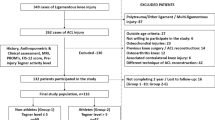Abstract
Purpose
The purpose of this study was to test whether low-grade Lachman test (i.e. Grade 0–1+) and a negative pivot shift at 6–12 weeks post-ACL rupture in recreational alpine skiers can be used to predict good function and normal knee laxity in nonoperated patients at minimum 2 years after the injury.
Methods
Office registry was used to identify 63 recreational alpine skiers treated by the senior author within 6 weeks of a first-time ACL injury between 2003 and 2008. Of these, 34 had early ACL reconstruction but 29 patients were observed and re-evaluated. Office charts and MRI were reviewed. Inclusion criteria for this study were as follows: ACL rupture documented on MRI after the injury, and minimum 2-year follow-up. Exclusion criterion was contralateral knee ligament injury. Of the 29 patients treated nonoperatively, 17 had low-grade Lachman and negative pivot shift tests within 6–12 weeks after the injury and were recommended to continue follow-up without surgery. Of these 17 patients, 6 were lost to follow up, but 11 patients were recalled and evaluated at more than 2 years after the injury. They completed Marx and Tegner activity level and IKDC subjective scores, physical examination of the knee and KT-1000 anterior laxity assessment.
Results
Median age at injury was 43 years (range 29–58). Median follow-up was 42 months (range 30–68). Mean IKDC subjective score at latest follow-up was 91.6 ± 6.7. Median Tegner score was 6 (range 6–9) before the injury and 6 (range 4–6) at latest follow-up (p = n.s). Median Marx score was 6 (range 0–16) before the injury and 4 (range 0–12) at latest follow-up (p = 0.03). Ten patients had Lachman Grade 0–1+, and one had Lachman Grade 2+ at latest follow-up. KT-1000 showed mean side-to-side difference of 0.8 ± 1.6 mm, and less than 3 mm difference in the 10 patients with Lachman Grade 0–1+.
Conclusion
Recreational alpine skiers who sustain ACL injury should be re-evaluated at 6–12 weeks after the injury rather than being operated acutely. If they have negative Lachman and pivot shift tests at that point, they can be treated without surgery since good outcome and normal knee anterior laxity at more than 2 years after the injury is expected.
Level of evidence
Case series, Level IV.



Similar content being viewed by others
References
Anderson AF, Irrgang JJ, Kocher MS, Mann BJ, Harrast JJ (2006) The international knee documentation committee subjective knee evaluation form: normative data. Am J Sports Med 34:128–135
Bouter LM, Knipschild PG, Volovics A (1989) Bindings function in relation to injury risk in downhill skiing. Am J Sports Med 17:226–233
Crain EH, Fithian DC, Paxton EW, Luetzow WF (2005) Variation in anterior cruciate ligament scar pattern: does the scar pattern affect anterior laxity in anterior cruciate ligament-deficient knees? Arthroscopy 21:19–24
Dunn WR, Lyman S, Lincoln AE, Amoroso PJ, Wickiewicz T, Marx RG (2004) The effect of anterior cruciate ligament reconstruction on the risk of knee reinjury. Am J Sports Med 32:1906–1914
Ekeland A, Holtmoen A, Lystad H (1993) Lower extremity equipment-related injuries in alpine recreational skiers. Am J Sports Med 21:201–205
Frobell RB, Roos EM, Roos HP, Ranstam J, Lohmander LS (2010) A randomized trial of treatment for acute anterior cruciate ligament tears. N Engl J Med 363:331–342
Fujimoto E, Sumen Y, Ochi M, Ikuta Y (2002) Spontaneous healing of acute anterior cruciate ligament (ACL) injuries—conservative treatment using an extension block soft brace without anterior stabilization. Arch Orthop Trauma Surg 122:212–216
Jonsson T, Althoff B, Peterson L, Renstrom P (1982) Clinical diagnosis of ruptures of the anterior cruciate ligament: a comparative study of the Lachman test and the anterior drawer sign. Am J Sports Med 10:100–102
Kostogiannis I, Ageberg E, Neuman P, Dahlberg L, Friden T, Roos H (2007) Activity level and subjective knee function 15 years after anterior cruciate ligament injury: a prospective longitudinal study of nonreconstructed patients. Am J Sports Med 35:1135–1143
Kostogiannis I, Ageberg E, Neuman P, Dahlberg LE, Friden T, Roos H (2008) Clinically assessed knee joint laxity as a predictor for reconstruction after an anterior cruciate ligament injury: a prospective study of 100 patients treated with activity modification and rehabilitation. Am J Sports Med 36:1528–1533
Levy BA (2010) Is early reconstruction necessary for all anterior cruciate ligament tears? N Eng J Med 363:386–388
Marx RG, Jones EC, Angel M, Wickiewicz TL, Warren RF (2003) Beliefs and attitudes of members of the American Academy of orthopaedic surgeons regarding the treatment of anterior cruciate ligament injury. Arthroscopy 19:762–770
Marx RG, Stump TJ, Jones EC, Wickiewicz TL, Warren RF (2001) Development and evaluation of an activity rating scale for disorders of the knee. Am J Sports Med 29:213–218
Meuffels DE, Favejee MM, Vissers MM, Heijboer MP, Reijman M, Verhaar JAN (2009) Ten year follow-up study comparing conservative versus operative treatment of anterior cruciate ligament ruptures. A matched-pair analysis of high level athletes. Br J Sports Med 43:347–351
Mirza F, Mai DD, Kirkley A, Fowler PJ, Amendola A (2000) Management of injuries to the anterior cruciate ligament: results of a survey of orthopaedic surgeons in Canada. Clin J Sport Med 10:85–88
Moksnes H, Risberg MA (2009) Performance-based functional evaluation of non-operative and operative treatment after anterior cruciate ligament injury. Scand J Med Sci Sports 19:345–355
Sernert N, Kartus J, Kohler K, Ejerhed L, Brandsson S, Karlsson J (2002) Comparison of functional outcome after anterior cruciate ligament reconstruction resulting in low, normal, and increased laxity. Scand J Med Sci Sports 12:47–53
Sulheim S, Ekeland A, Bahr R (2007) Self-estimation of ability among skiers and snowboarders in alpine skiing resort. Knee Surg Sports Traumatol Arthrosc 15:665–670
Tegner Y, Lysholm J (1985) Rating systems in the evaluation of knee ligament injuries. Clin Orthop Relat Res 198:43–49
Author information
Authors and Affiliations
Corresponding author
Rights and permissions
About this article
Cite this article
Hetsroni, I., Delos, D., Fives, G. et al. Nonoperative treatment for anterior cruciate ligament injury in recreational alpine skiers. Knee Surg Sports Traumatol Arthrosc 21, 1910–1914 (2013). https://doi.org/10.1007/s00167-012-2324-8
Received:
Accepted:
Published:
Issue Date:
DOI: https://doi.org/10.1007/s00167-012-2324-8




